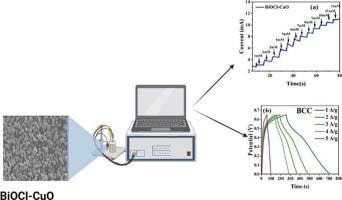BiOCl–CuO nanocomposite as a bifunctional material for glucose detection and energy storage
IF 4.2
Q2 CHEMISTRY, MULTIDISCIPLINARY
引用次数: 0
Abstract
A BiOCl–CuO (BCC) nanocomposite was synthesized via a solvothermal method and characterized for its dual electrochemical applications in glucose sensing and supercapacitors. High-resolution scanning electron microscopy (HR-SEM) revealed a nanosphere morphology, while electrochemical impedance spectroscopy (EIS) and Brunauer–Emmett–Teller (BET) analysis demonstrated a low charge transfer resistance (6.95 Ω) and a high specific surface area (124.5 m2/g), respectively. The synergistic interaction between BiOCl and CuO enhanced glucose adsorption and oxidation, yielding a sensitivity of 0.718 mA mM−1 cm−2 and a detection limit of 0.48 mM, as determined by chronoamperometry. In supercapacitor applications, BCC exhibited superior electrochemical performance compared to pure BiOCl, with a higher specific capacitance of 684.92 Fg−1, prolonged discharge time, and excellent cycling stability. These findings highlight the potential of BCC as a multifunctional material for high-performance glucose sensors and energy storage devices.

BiOCl-CuO纳米复合材料作为葡萄糖检测和能量存储的双功能材料
采用溶剂热法合成了一种BiOCl-CuO (BCC)纳米复合材料,并对其在葡萄糖传感和超级电容器中的双重电化学应用进行了表征。高分辨率扫描电镜(HR-SEM)显示了纳米球形态,电化学阻抗谱(EIS)和brunauer - emmet - teller (BET)分析分别显示了低电荷转移电阻(6.95 Ω)和高比表面积(124.5 m2/g)。BiOCl和CuO之间的协同作用增强了葡萄糖的吸附和氧化,产生0.718 mA mM−1 cm−2的灵敏度和0.48 mM的检测限,通过计时电流测定。在超级电容器应用中,BCC表现出优于纯BiOCl的电化学性能,具有更高的比电容(684.92 Fg−1)、更长的放电时间和优异的循环稳定性。这些发现突出了BCC作为高性能葡萄糖传感器和能量存储设备的多功能材料的潜力。
本文章由计算机程序翻译,如有差异,请以英文原文为准。
求助全文
约1分钟内获得全文
求助全文

 求助内容:
求助内容: 应助结果提醒方式:
应助结果提醒方式:


